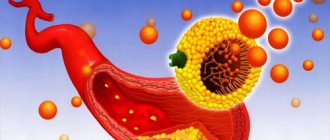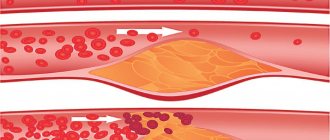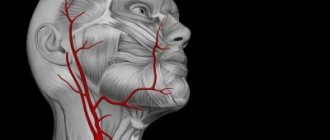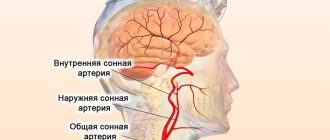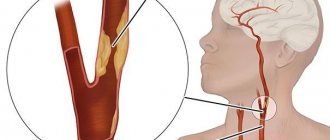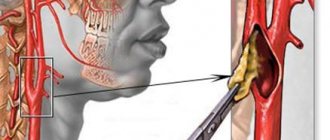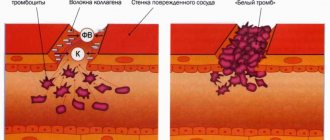0
Author of the article: Marina Dmitrievna
2017.10.22
15 739
Vessels
Due to an inactive lifestyle, bad habits, and poor nutrition, modern people are increasingly faced with vascular diseases. The most common and truly dangerous disease is vascular atherosclerosis. You can get rid of it, but you need to radically change your lifestyle. Atherosclerosis is the process of growth of fatty deposits in the form of harmful cholesterol on the walls of blood vessels. If the fight is not started in time, the risk of blood clots, which are the root cause of heart attack and stroke, increases.
Stroke
It is especially dangerous if plaques form in the vessels of the cervical spine. Cervical arteries are conductors of blood and oxygen to the brain. When the cervical region has problems, a person must understand the danger of the condition. If a blood clot is rejected, the risk of a stroke is high. How to get rid of plaques in the vessels of the neck?
What is a plaque?
Before understanding the methods of treating atherosclerosis, it is necessary to understand the structural features of plaque in the vessels of the cervical spine. How to get rid of it? This is a different question, since it is important to know how to prevent their accumulation in the body.
The composition of the plaque in the vessel is a fatty substance, a lipid, which is harmful cholesterol. At the initial stages, the vessel is covered with a thin layer of cholesterol, but over time, an increase in these substances occurs. The process occurs not only in the neck area, but throughout the body. Focusing on the neck is due to the close proximity of the vessels to the brain.
Atherosclerotic plaque and thrombus
When a lot of cholesterol accumulates, a blood clot forms. Once in the bloodstream, a blood clot can lead to blockage of blood vessels in the brain and heart, which leads to tissue death. A plaque in a neck vessel is a potential danger that, without treatment, can lead to disastrous results.
Therapy
If plaques are found in the vessels of the neck, then the patient must radically change his lifestyle:
- Start eating right;
- Exercise;
- Give up bad habits;
- Increase physical activity during the day;
- Take medication.
You should also strengthen the immune system by taking vitamin supplements, using a contrast shower, and regular walks in the fresh air. It is highly not recommended to self-medicate, which can lead to disastrous consequences.
Drug therapy
To cure cervical vascular atherosclerosis, it is necessary to use medications whose action is aimed at combating lipid plaques:
| Name of pharmacological group | Name of the medicine | Medicinal action |
| Fibrates | Cholestide, Bezafibrate, Ezetimibe, Fenofibrate | Strengthening the activity of the enzyme that provokes the division of cholesterol, preventing the formation of triglycerides. |
| Preparations based on niacin (nicotinic acid) | Niceritrol, Acipimox, Enduracin | Normalization of metabolism in the body, increase in protective properties, stimulation of brain function, expansion of the lumen of blood vessels, thinning of the blood, stabilization of blood pressure (BP). |
| Statins | Simvastatin, Atorvastatin, Mertenil, Pitavastatin, Liprimar | Blocking the production of a compound that is involved in the synthesis of “bad” cholesterol, as well as the removal of low-density lipoproteins from the body. |
Diet
An important factor in successful treatment is adherence to a special diet. It is necessary to exclude from the diet:
- Fatty foods;
- Smoked meats;
- Fried foods;
- Over-salted foods;
- Mayonnaise, various sauces;
- fast food;
- Baked goods, sweets;
- By-products;
- Conservation;
- Products containing lipids of animal origin.
The maximum permissible caloric content of the diet in the presence of plaques in the vessels of the neck is 2 – 2.5 thousand kcal. Dishes must be cooked by baking, boiling or steaming. Butter made from cream must be replaced with any vegetable oil, but do not overuse it.
It is allowed to eat 1 egg for tomorrow, 0.2 kg of a dish containing a large amount of protein for lunch and no more than 0.15 kg of such food for dinner.
The diet should be dominated by foods high in fiber, in particular fruits, vegetables, grains, as well as:
- Lean fish;
- Nuts;
- Dried fruits;
- Rabbit, veal, skinless chicken and/or turkey;
- Bran;
- Low-fat fermented milk products;
- Greenery;
- Seafood;
- Cereal dishes.
It is necessary to control the drinking regime. The daily consumption rate of purified water is 1.5 – 2 liters.
Water helps thin the blood and cleanse it of toxic compounds. In addition, it would not be amiss to include fruit drinks, compotes, and herbal tea in the menu, which will nourish the body with useful elements.
Treatment with folk remedies
Alternative medicine can also help eliminate cholesterol plaques. However, this method should be auxiliary. Herbal medicine involves making your own medicines or purchasing herbal infusions at a pharmacy:
| folk remedy | Required Components | Preparation method | Reception scheme |
| Tincture of elecampane and propolis | For this medicine you will need propolis tincture and elecampane root in equal proportions, as well as 1 tbsp. vodka. |
| Take 20-25 drops on an empty stomach before the first and last meals (2 times a day). |
| Garlic infusion | You need to prepare 1 liter of boiled water and 1 head of garlic cloves. |
| Take 1 large spoon after waking up on an empty stomach. |
| Medicine with honey and plantain |
|
| Use once/day. 2 b. l. after eating. |
| Herbal collection |
|
| Drink the prepared medicine 1/3 tbsp. 3 rubles/day |
| Dandelion infusion | To make the medicine you will need hot boiled water and dried dandelion root. |
| Divide the resulting medicine into 3 doses, consume 1/3 hour before meals. The recommended therapeutic course is 2 months. |
| Licorice root decoction | To prepare the decoction you will need ½ liter of boiling water and 40 g of medicinal root. |
| Take 1/3 tbsp. after a meal 4 rubles/day for 21 days. |
The first of the presented manufacturing methods can be used for infusion:
- Dandelion;
- Licorice;
- Celandine;
- Linden trees;
- Corn silk;
- Willow bark;
- Immortelle;
- Mint.
Both infusion and evaporation of medicinal plants are acceptable. Additionally, the herbs can be brewed and consumed as tea. However, before taking it, it is recommended to dilute the resulting infusion with boiled water in equal proportions.
It is also allowed to consume whole decoctions on an empty stomach, 1.5 b. l. twice/day For atherosclerosis, it is allowed to take herbal baths, since the skin can absorb beneficial substances.
Treatment of atherosclerosis of the cervical vessels with folk remedies, as well as with medications, should be prescribed by the attending physician, which is especially important for patients suffering from various chronic pathologies.
Since medicinal plants have some contraindications. This will help avoid negative consequences for the body. The doctor must also determine the appropriate dosage of the medicine.
Operation
Surgery is indicated for significant vascular damage and an increased risk of narrowing of their lumen. Removing the lipid layer surgically is a temporary solution to the problem, since surgery does not reduce the level of low-density lipoproteins in the blood.
To restore blood circulation, the following types of surgical treatment are used:
| the name of the operation | Characteristic |
| Carotid endarterectomy | This procedure is a cleansing of the arteries. To do this, the surgeon cuts the affected vessel with a laser, cleans out fatty deposits from it, and then stitches it together. |
| Bypass surgery | Bypass surgery is the establishment of another path in a damaged vessel for blood to pass through. |
| Stenting | Endoscopic intervention is characterized by the installation of a stent tube into the lumen of the vessel in which pathological changes occur. This allows it to expand and ensure normal blood circulation. |
Even after one of the mechanical methods of removing atherosclerotic deposits has been carried out, the patient must adhere to a diet and a healthy lifestyle for a long time. This will prevent further blockage of other vessels.
Causes of increased cholesterol
It cannot be said that atherosclerosis can develop in one part of the back, neck, etc. This is a disease that affects the entire body. Doctors believe the reasons for the increase in cholesterol are:
- Lipid metabolism disorders.
- Hereditary factor.
- Hypertension.
- Diabetes.
- Obesity.
- Alcohol abuse.
- Smoking.
- Poor nutrition, consumption of fatty and excessively salty foods.
- Frequent stress.
- Sedentary lifestyle.
This negatively affects human health.
Diagnostics
Atherosclerosis can be visually diagnosed if cholesterol fills 50 percent of the vessel area. To correct cholesterol in the early stages of the disease, donating blood for analysis is used.
Reasons influencing the development of the disease
A cholesterol plaque forms on the vascular wall with systematically elevated lipid levels. This condition is provoked by the following factors:
- abuse of addictions;
- endocrine pathologies;
- excessive body weight;
- disruptions in carbohydrate metabolism;
- elevated blood pressure;
- sedentary lifestyle;
- viral and infectious pathologies;
- psycho-emotional shocks.
Return to contents
Symptoms
Often, a cholesterol plaque in a neck vessel is called a “silent enemy” that does not make its existence known for a long time. For years, or even decades, a person may not suspect an increase in the amount of cholesterol deposits. If we talk about the symptoms that may appear during the disease, they are as follows:
- Frequent headaches, dizziness.
- General weakness.
- Fast fatiguability.
- Numbness of the limbs.
- Floaters in the eyes.
- Decreased visual acuity.
- Insomnia.
- Lack of feeling of stability while walking.
- Apathy.
Treatment of neck vessels due to the accumulation of cholesterol plaques can be traditional and non-traditional. In any case, you need to seek help from a general practitioner who will prescribe diagnosis and therapy. The more lipid deposits, the more pronounced the symptoms will appear.
Symptoms
With atherosclerosis of the carotid arteries, its symptoms are initially invisible.
As a rule, the early stage of the disease is discovered by chance when some other pathology is diagnosed.
However, even at the onset of the disease, due to oxygen deficiency in the brain, the following symptoms occur:
- increased fatigue;
- difficulty concentrating;
- insomnia;
- heaviness in the head;
- emerging tinnitus;
- memory problem.
If these symptoms occur, you must contact a medical facility.
With further development of the disease, the patency of the carotid arteries decreases even more, which leads to the so-called transient ischemic attack, the symptoms of which disappear after a day.
Its symptoms are as follows:
- speech disorder;
- vision in the right or left eye is impaired or completely lost;
- imbalance;
- numbness in the left or right side of the face and the appearance of asymmetry in it.
The appearance of at least one sign indicates an increased risk of developing ischemic stroke. It is necessary to urgently consult a doctor.
Standard approaches to the treatment of early stage atherosclerosis
It is necessary to fight cholesterol plaques at the stage of early atherosclerosis, when the substance just begins to fill the walls of blood vessels and does not accumulate. What medicine will help remove atherosclerotic plaques in the vessels of the neck? Treatment does not always involve taking medications.
Proper nutrition
At an early stage of the disease, the doctor may recommend changing your usual lifestyle as treatment. What should I do for this?
- Change your usual diet. Diet is the assistant that will reduce the amount of cholesterol in the blood.
- Increase the amount of physical activity if your health allows. Only through timely expenditure of calories can you get rid of fat deposits under the skin and in the blood vessels.
- Avoid drinking coffee frequently. It is permissible to drink no more than 2 cups per day.
- Avoid alcohol and smoking at least for the period of treatment.
- Increase your drinking of plain purified water to speed up your body's metabolism.
- People over 40 should donate blood for analysis and undergo examinations in a timely manner.
If your doctor prescribes medications to treat high cholesterol, take them as directed. You should not cancel or extend the duration of taking medications on your own.
Prevention
Atherosclerosis of the cervical vessels can be called a pathology of unhealthy lifestyle. Therefore, the patient needs to reconsider his lifestyle, start eating right, and give up bad habits. The sooner the patient thinks about his life, the less likely it is that cardiovascular failure will develop.
If you approach treatment measures thoroughly and follow absolutely all the recommendations of specialists, then it is possible to remove plaques from the cervical spine. However, in some cases, the pathology develops at lightning speed and is diagnosed at an already advanced stage. In this case, surgical intervention cannot be avoided. The main goal will be to increase the lumen of the arteries, which will help save life and improve its quality.
What can and cannot be eaten with vascular atherosclerosis?
What foods are plaques in the vessels of the cervical spine afraid of? How to get rid of the disease? First of all, completely abandon:
- Fatty foods.
- Fast food.
- Pork.
- Chicken liver.
- Excessively salted and canned products.
- Smoked meats.
- Sweets based on vegetable fats and margarines.
- Fatty dairy products.
- Egg yolks.
- Bakery products.
- Mayonnaise.
- Sunflower oil (in large quantities).
- Canned meat and fish products.
To reduce cholesterol levels in blood vessels, you need to consume the following foods:
- Vegetables and fruits.
- Bran.
- Dietary meat (chicken, turkey, rabbit).
- Lean fish.
- Low-fat fermented milk products.
- Cereals.
- Greenery.
- Dried fruits.
- Nuts.
- Green and herbal tea.
This is a standard list of products that will help treat early atherosclerosis. For complex cases, nutritional adjustments are not enough. The accumulation of plaques in severe cases is viewed using special computer equipment.
Atherosclerosis
There is no such thing in the medical dictionary as “cervical plaques.” In the language of Aesculapians, the disease sounds like atherosclerosis. Atherosclerosis is a quietly developing chronic disease associated with damage to blood vessels.
Disturbances in the structure of natural organic compounds such as lipids and proteins, as well as in their interaction, lead to the appearance of bad cholesterol as a residual phenomenon in the hematopoietic system. Then, through a not very complex chemical process, so-called plaques are formed on the walls of blood vessels.
Attention! Cholesterol plaques are an unnatural concentration of a fat-like substance/cholesterol, calcium found in the blood of the vascular cavity, as well as connective tissue fibers and fatty waste formed on their walls.
Even in the last century, no importance was attached to this, but today cholesterol is one of the worst enemies of human health, destroying it from the inside. The cervical spine suffers for various reasons: constant stress, lack of mobility, stagnation.
The danger of this problem is that the cervical vessels are directly connected to the brain; it is they, through the blood flow, that transport oxygen and various nutrients to the human brain. Atherosclerosis (plaques) makes blood vessels flabby, clogs them, and accordingly the functioning of the hematopoietic system deteriorates. The nutrition of the brain is disrupted. Memory deteriorates, frequent headaches appear, a stroke is possible, and therefore death. In the case of healthy blood vessels, a person prolongs not just his life, but active brain activity, reserving the right to be called a reasonable person.
Causes of atherosclerosis/plaques in the cervical spine
The formation of cholesterol plaques is a consequence of an inflammatory process. The above reasons affect the inner surface of blood vessels, into which “harmful/bad” cholesterol easily penetrates. The interaction of the latter with oxygen in the blood is especially dangerous. The immune system reacts by perceiving what is happening as an inflammatory attack on the body. The response to the process is the appearance of macrophages (white blood cells). Damage to the inner walls of blood vessels continues with renewed vigor: macrophages, cholesterol and inflammatory proteins form a cholesterol/atherosclerotic plaque.
Previously, the most obvious and active cause of the appearance of plaques was considered to be alcohol addiction or smoking. Modern research has made it possible to expand the range of reasons, so the second reason, in terms of the scale of the detrimental effect on the body, will be unhealthy diet. But that's not all.
It is important to know that recent studies claim that the appearance of atherosclerotic plaques is also influenced by an insufficient amount of daily drinking water taken by a person. Doctors also identify as a reason:
- stress;
- heredity;
- inactivity;
- chronic diseases hypertension, diabetes, obesity.
You should know that these diseases, again, most often result from a violation of the general regime.
Traditional methods of treating blood vessels
If a person does not trust traditional medicine, then he needs to know how to get rid of cervical plaques using folk remedies. Home treatments, when done correctly, can help reduce harmful plaque levels.
Important! Before adding traditional medicine to drug treatment, you should consult a doctor for advice. It happens that a person does not know about the consequences of an incorrect dosage of herbal tea or tincture. Don't underestimate the power of folk remedies.
A mixture of garlic, lemon and horseradish
It is recommended on online forums to remove bad cholesterol with a mixture of lemon and garlic. This is a classic mixture that has long been popular among healers.
Lemon and garlic
The recipe has been improved, as horseradish root has been added to the composition.
Attention! The recipe is contraindicated for people with diseases of the gastrointestinal tract.
To prepare, take 250 g of lemon, 100 g of garlic and 100 g of horseradish. Grind into a meat grinder. It is advisable to chop the lemon together with the peel. Add 200 ml of boiled water at room temperature to the finished mixture. Stir and refrigerate overnight. Take a tablespoon three times a day 30 minutes before your main meal. Be sure to add a teaspoon of natural honey to a spoonful of the mixture. Course – 1 month. Per year, carry out a maximum of 3 such vessel cleanings.
Linden powder
Linden is a diuretic, so it is recommended for the treatment of obesity. The recipe is not recommended for those who have problems with the urinary system.
To prepare, grind dry linden blossom in a coffee grinder to a powder. Take the prepared powder one teaspoon three times a day. The course of treatment is 4 weeks.
Dandelion root infusion
Dandelion infusion will help reduce the number of plaques in the neck area. The recipe has virtually no contraindications. To prepare, grind dry dandelion root to a powder. Pour 1 teaspoon of powder into 100 ml of hot water. Take 20 minutes before meals 3 times a day. The course of treatment is 2 months.
Licorice root infusion
This folk remedy is affordable and effective in combating blockage of blood vessels due to cholesterol. To prepare, pour 40 g of crushed licorice roots into 0.5 liters of boiling water. An important condition is to boil the composition for 10 minutes over low heat. Afterwards, strain the finished mixture. Take one third of a glass 4 times throughout the day after meals. The course of treatment is 3 weeks.
Common thyme
If there is blockage of the arteries of the cervical spine with sclerotic plaques, then this is fraught with cerebral atherosclerosis.
To relieve vascular spasm, you can use thyme infusion. To obtain it, you will need to take 20 g of raw material, add 500 ml of boiling water, cover the container and set aside for 40 minutes.
Filter the cooled broth through cheesecloth. Place 5 drops of golden mustache juice in 200 ml of the prepared product. The infusion is potent, so take it no more than 3 times a week. The duration of therapy will be 4 months. Thyme not only relieves spasms, but also has a calming and bactericidal effect.
Surgical techniques
Surgical treatment of the problem is considered in two cases: with a high risk of blockage and with serious damage to the blood vessels. Removing cholesterol in the form of a lipid layer is a temporary solution, but the operation does not reduce the amount of bad cholesterol.
Vessel stenting
To restore normal blood flow, the following types of operations are used:
- Shunting. Often surgery saves the lives of people who have heart problems. Doctors establish a “bypass” path for blood flow at the site of vessel damage.
- Carotid endarterectomy. The procedure is aimed at combating deposits. The cleaning vessel is cut, cleaned, and then sewn together.
- Stent installation. The manipulation allows you to permanently leave the vessel of the required width for normal blood circulation. Stents are installed in places where there is severe narrowing of the vessel.
These types of surgical interventions cannot guarantee a complete reduction in cholesterol levels, as they resolve the issue locally. The patient still needs to monitor his health, nutrition and lifestyle.
Removal of cholesterol plaques in the carotid artery
Removal of cholesterol plaques on the carotid artery at the second stage (fibrosis) and at the third stage (calcionosis) can occur in several ways:
- increasing blood (arterial) pressure - but this path is fraught with the formation of new damage to blood vessels and, as a consequence, the formation of new atherosclerotic deposits;
- dilatation of blood vessels, however, this method is ineffective on the carotid artery and is used more often for varicose veins of the extremities;
- increased tone of blood vessels;
- cleansing the blood of cholesterol - however, this method does not so much destroy existing plaques as prevent the formation of new ones.
The cost of removing cholesterol plaques on the carotid artery using medications is entirely determined by the cost of the drugs used. The cost of surgical treatment (carotid endarterectomy, angioplasty, stenting) is even higher if it is not done according to the insurance policy. Surgical treatment is resorted to when conservative methods fail.
Conservative methods of removing cholesterol plaques include taking specialized medications, increasing the proportion of foods in the diet that cleanse blood vessels of cholesterol, performing (daily) therapeutic exercises for atherosclerosis, and taking statins or other medications for high cholesterol.
How to remove cholesterol plaques from the carotid artery safely? Surgery has some risks, and drug treatment has contraindications and side effects. Drug treatment can be aimed at reducing the level of cholesterol synthesis by the liver, increasing energy metabolism in cells - this is how it is possible to remove excess cholesterol from the blood and carotid arteries. An alternative is infusions and herbs for cholesterol plaques, but their effectiveness remains unproven.
Reduce cholesterol with pills
To combat lipid plaques, modern medicine has chosen three main directions:
- Taking statin-based drugs.
- Treatment with drugs based on fibric acid.
- Based on nicotinic acid.
It is appropriate to prescribe drugs based on these substances in case of severe damage to blood vessels by cholesterol, since medications have a number of side effects. Statins can have the greatest effect because they block the enzymes responsible for the body's production of cholesterol. For additional therapy, doctors simultaneously prescribe vitamin complexes.
The following medications are often prescribed to combat plaque:
- Mertenil.
- Choledol.
- Crestor.
- Rosecard.
These are new generation drugs, so they are prescribed more and more often. Drugs that are similar in composition to Clofibrate are rarely used because they cause serious side effects.
The problem of high cholesterol in the blood must be solved comprehensively and with the help of a doctor.
Diagnostics
Diagnostic testing for this disease consists of the following:
- Based on the patient’s complaints, the doctor first prescribes an ultrasound scan using contrast agents. After analyzing the research obtained, a conclusion is made about blood circulation and the structure of blood vessels;
- if the doctor considers that ultrasound is not sufficient to diagnose this disease, then a computed tomography may be prescribed. Using X-rays and the use of contrast, a picture of the structure of the patient’s blood vessels is created;
- may prescribe magnetic resonance therapy, a painless procedure that can be used to study not only the blood flow and structure of the patient’s arteries, but also the condition of small vessels;
- Angiography is very rarely prescribed, although such a study makes it possible to obtain and visually see all the changes that have occurred in the vessels. But the possibility of damaging the plaque and getting any complications, including ischemic stroke, with such an examination is too high.

